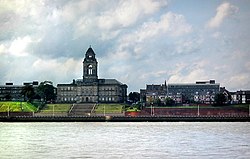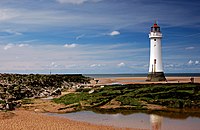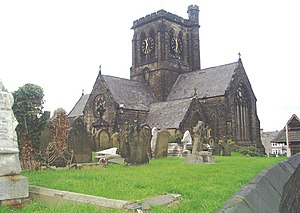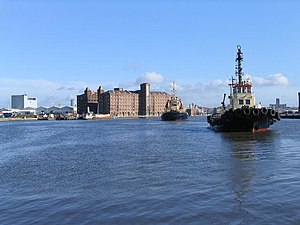Wallasey: Difference between revisions
No edit summary |
m clean up, typos fixed: merged together → merged, four mile → four-mile |
||
| Line 38: | Line 38: | ||
=== Seacombe === | === Seacombe === | ||
Seacombe, the most southeasterly section of Wallasey, is best known for its Mersey Ferry terminal, with regular ferry boat departures to Pier Head in Liverpool and Woodside in Birkenhead. There is a commuter ferry service direct to Liverpool during peak hours, while for the rest of the day the ferries are geared to serving tourists with a circular cruise visiting Birkenhead Woodside ferry terminal as well. Seacombe is the last remaining of the three ferry terminals which used to connect the Borough of Wallasey, the others being Egremont Ferry and the New Brighton Ferry, which operated from its own pier, running parallel to the New Brighton pleasure pier. Seacombe Ferry is also the starting point of a four mile unbroken promenade, mostly traffic-free, running alongside the River Mersey to Harrison Drive beyond New Brighton. | Seacombe, the most southeasterly section of Wallasey, is best known for its Mersey Ferry terminal, with regular ferry boat departures to Pier Head in Liverpool and Woodside in Birkenhead. There is a commuter ferry service direct to Liverpool during peak hours, while for the rest of the day the ferries are geared to serving tourists with a circular cruise visiting Birkenhead Woodside ferry terminal as well. Seacombe is the last remaining of the three ferry terminals which used to connect the Borough of Wallasey, the others being Egremont Ferry and the New Brighton Ferry, which operated from its own pier, running parallel to the New Brighton pleasure pier. Seacombe Ferry is also the starting point of a four-mile unbroken promenade, mostly traffic-free, running alongside the River Mersey to Harrison Drive beyond New Brighton. | ||
Local landmarks are St Paul's Church, standing on its own traffic island, and the ventilation tower for the Kingsway Tunnel with its mighty extraction fans. As with Poulton, the area developed with housing for the dockworkers and nearby industries, and much of the housing is owned by Wirral Partnership Homes or are terraced. The Guinea Gap swimming baths are located between Seacombe and Egremont. | Local landmarks are St Paul's Church, standing on its own traffic island, and the ventilation tower for the Kingsway Tunnel with its mighty extraction fans. As with Poulton, the area developed with housing for the dockworkers and nearby industries, and much of the housing is owned by Wirral Partnership Homes or are terraced. The Guinea Gap swimming baths are located between Seacombe and Egremont. | ||
| Line 63: | Line 63: | ||
During the latter half of the 19th century New Brighton developed as a very popular seaside resort serving [[Liverpool]] and the other [[Lancashire]] industrial towns, and many of the large houses were converted to inexpensive hotels. A pier was opened in the 1860s, and the promenade from Seacombe to New Brighton was built in the 1890s. This served both as a recreational amenity in its own right, and to link up the developments along the estuary, and was later extended westwards towards Leasowe. The New Brighton Tower, the tallest in the country, was opened in 1900 but closed in 1919 and dismantled shortly afterwards. However, its ballroom continued as a major venue, hosting numerous concerts in the 1950s and 1960s by local Liverpool bands as well as other international stars. | During the latter half of the 19th century New Brighton developed as a very popular seaside resort serving [[Liverpool]] and the other [[Lancashire]] industrial towns, and many of the large houses were converted to inexpensive hotels. A pier was opened in the 1860s, and the promenade from Seacombe to New Brighton was built in the 1890s. This served both as a recreational amenity in its own right, and to link up the developments along the estuary, and was later extended westwards towards Leasowe. The New Brighton Tower, the tallest in the country, was opened in 1900 but closed in 1919 and dismantled shortly afterwards. However, its ballroom continued as a major venue, hosting numerous concerts in the 1950s and 1960s by local Liverpool bands as well as other international stars. | ||
After 1886, with the opening of the Mersey Railway allowing access via a tunnel to Liverpool, the pace of housing development increased, particularly in the Liscard and Wallasey Village areas. The area now called Wallasey comprises several distinct districts which gradually merged | After 1886, with the opening of the Mersey Railway allowing access via a tunnel to Liverpool, the pace of housing development increased, particularly in the Liscard and Wallasey Village areas. The area now called Wallasey comprises several distinct districts which gradually merged to form a single built-up area during the 19th and early 20th centuries. Further growth continued well into the 20th century and eventually spread into the Leasowe area and beyond to Moreton. | ||
The United Kingdom's first guide dog training school, the Guide Dogs for the Blind Association, was founded in the town in 1931. The Wallasey Golf Club is where club member, Dr Frank Stableford, developed the Stableford system of points scoring. This was first used in competition in 1932.<ref>{{cite web |url=http://www.wallaseygolfclub.com/stableford.html |title=Dr Frank Stableford |publisher=Wallasey Golf Club |accessdate=2009-07-21}}</ref> | The United Kingdom's first guide dog training school, the Guide Dogs for the Blind Association, was founded in the town in 1931. The Wallasey Golf Club is where club member, Dr Frank Stableford, developed the Stableford system of points scoring. This was first used in competition in 1932.<ref>{{cite web |url=http://www.wallaseygolfclub.com/stableford.html |title=Dr Frank Stableford |publisher=Wallasey Golf Club |accessdate=2009-07-21}}</ref> | ||
Latest revision as of 13:41, 27 January 2016
| Wallasey | |
| Cheshire | |
|---|---|
 Wallasey Town Hall | |
| Location | |
| Grid reference: | SJ293923 |
| Location: | 53°25’23"N, 3°3’54"W |
| Data | |
| Population: | 58,710 (2001) |
| Post town: | Wallasey |
| Postcode: | CH44 |
| Dialling code: | 0151 |
| Local Government | |
| Council: | Wirral |
| Parliamentary constituency: |
Wallasey |
Wallasey is a town which stands at the northeastern corner of the Wirral Peninsula in Cheshire, north of Birkenhead washed on one side by the mouth of the River Mersey and on another by the Irish Sea. According to the 2001 Census, the town had a total resident population of 58,710.
Wallasey is not so much a town in itself as a collection of towns or villages grown together and as such it comprises several distinct districts; Egremont, Liscard, New Brighton, Poulton, Seacombe and Wallasey Village. These villages grew together to form a single built-up area during the 19th and early 20th centuries. Consequently, there is no single Wallasey town centre. The main shopping area is in Liscard.
Liscard
Liscard contains the main shopping area of the Wallasey towns. It has the covered Cherry Tree precinct and an extensive shopping parade outside. Central Park, originally the grounds of Liscard Hall, is the largest park in the town. Much of the area is residential and contains mainly high-density semi-detached housing with some terraces. The gatehouse of the old Liscard Battery remains.
Liscard Hall was destroyed by a fire on 7 July 2008. The damage was so severe, the whole building had to be demolished.[1][2]
Wallasey Village
Wallasey Village has a mixture of popular mostly 20th century semi-detached and detached housing, a shopping street, with a floral roundabout in the centre. It is considered the wealthiest area of Wallasey. St Hilary's Church is an ancient foundation; the old tower is all that remains of a 1530 church building which burned down in 1857. There are two railway stations; Wallasey Village and Wallasey Grove Road. At the north end of Wallasey Village, the main street leads to the promenade and coastal park, and two golf courses. The promenade passes here, running from the 'Gunsite' around to Seacombe, a total of over 7 miles.
New Brighton

New Brighton was created as seaside resort in the mid-19th century and remained popular until a the rise in foreign holidays after the 1950s. Nevertheless, the marine promenade is part of a popular walk and the areas near the sea offer a much improved beach and many leisure activities. The Floral Pavilion plays host to regular productions and national stars such as Ken Dodd, and Vale Park is a beautiful public park. Housing here ranges from large villas near the sea to suburban semi-detached homes, while there are some less attractive terraces in parts of the area. New Brighton is served by a railway station of the same name. New Brighton promenade is the United Kingdom's longest promenade.
Poulton
Poulton was originally a small fishing and farming hamlet beside the Wallasey Pool (hence its name). It developed with the growth of the docks, mainly as an industrial and terraced housing area.
Egremont
Egremont developed as an affluent residential area in the early 19th century, and was named by one Captain Askew who built a house in the area in 1835 and named it after his birthplace in Cumberland. Egremont Pier was built in 1827 and was the longest pier in the area until it was damaged irreparably in 1946 when a coaster collided with it. Wallasey Town Hall, an imposing edifice opened in 1916 and initially used as a war hospital, is found here, overlooking the estuary and with its back to the town. This area is now almost entirely housing, although there is a small shopping area on King Street.
Seacombe
Seacombe, the most southeasterly section of Wallasey, is best known for its Mersey Ferry terminal, with regular ferry boat departures to Pier Head in Liverpool and Woodside in Birkenhead. There is a commuter ferry service direct to Liverpool during peak hours, while for the rest of the day the ferries are geared to serving tourists with a circular cruise visiting Birkenhead Woodside ferry terminal as well. Seacombe is the last remaining of the three ferry terminals which used to connect the Borough of Wallasey, the others being Egremont Ferry and the New Brighton Ferry, which operated from its own pier, running parallel to the New Brighton pleasure pier. Seacombe Ferry is also the starting point of a four-mile unbroken promenade, mostly traffic-free, running alongside the River Mersey to Harrison Drive beyond New Brighton.
Local landmarks are St Paul's Church, standing on its own traffic island, and the ventilation tower for the Kingsway Tunnel with its mighty extraction fans. As with Poulton, the area developed with housing for the dockworkers and nearby industries, and much of the housing is owned by Wirral Partnership Homes or are terraced. The Guinea Gap swimming baths are located between Seacombe and Egremont.
History
Early history
Before the 19th century the area was sparsely populated. Horse races organised for the Earls of Derby on the sands at Leasowe in the 16th and 17th centuries are regarded as forerunners of the modern Epsom Derby|Derby.[3]
Old maps show that the main centre and parish church (St Hilary's) were located at what is now called Wallasey Village, and there were smaller hamlets at Liscard, Poulton and Seacombe, from where there were occasional ferries across the Mersey. There was also a mill (at Mill Lane), and from the mid-18th century a gunpowder store or magazine at Rock Point, located well away from the built-up areas.

The main activities in the area were farming and fishing. The area also had a reputation for smuggling and "wrecking",[4] the act of luring ships onto rocks or sandbanks with false lights in order to raid their cargo. Underground cellars and tunnels, which were used to hide cargo pilfered from wrecked ships still exist in the town.[5] As late as 1839, the "Pennsylvania" and two other ships were wrecked off Leasowe in a severe storm, and their cargoes and furnishings were later found distributed among local residents.[6]
Early 19th century development
By the early 19th century, the shoreline between Seacombe and Rock Point started to become an attractive area to which affluent Liverpool merchants and sea captains could retire. Development at Egremont began around this time, and gained pace with the introduction of steam ferries across the river. The area also had a defensive role overlooking the growing Port of Liverpool. In 1829, Fort Perch Rock was built, and in 1858 Liscard Battery.
In 1830, the merchant James Atherton purchased much of the land at Rock Point, which enjoyed views out to sea and across the Mersey and had a good beach. His aim was to develop it as a desirable residential and watering place for the gentry, in a similar way to one of the most elegant seaside resorts of that Regency period – hence "New Brighton". Substantial development began soon afterwards, and housing began to spread up the hillside overlooking the estuary - the gunpowder magazine being closed down in 1851.

In 1835 Liscard Hall was built by another merchant, Sir John Tobin. Its grounds later became Central Park. His family also developed a "model farm" nearby.
With the expansion of trade on the Mersey, new docks were constructed between 1842 and 1847 in the Wallasey Pool, and by 1877 the dock system between Wallasey and neighbouring Birkenhead was largely complete. The area around the docks became a centre for engineering industries, many associated with shipbuilding, and other activities including sugar refining and the manufacture of cement and fertilisers. Bidston Dock, the last in the area, was opened in 1933, but was filled in during 2003.
Later growth and the 20th century
During the latter half of the 19th century New Brighton developed as a very popular seaside resort serving Liverpool and the other Lancashire industrial towns, and many of the large houses were converted to inexpensive hotels. A pier was opened in the 1860s, and the promenade from Seacombe to New Brighton was built in the 1890s. This served both as a recreational amenity in its own right, and to link up the developments along the estuary, and was later extended westwards towards Leasowe. The New Brighton Tower, the tallest in the country, was opened in 1900 but closed in 1919 and dismantled shortly afterwards. However, its ballroom continued as a major venue, hosting numerous concerts in the 1950s and 1960s by local Liverpool bands as well as other international stars.
After 1886, with the opening of the Mersey Railway allowing access via a tunnel to Liverpool, the pace of housing development increased, particularly in the Liscard and Wallasey Village areas. The area now called Wallasey comprises several distinct districts which gradually merged to form a single built-up area during the 19th and early 20th centuries. Further growth continued well into the 20th century and eventually spread into the Leasowe area and beyond to Moreton.
The United Kingdom's first guide dog training school, the Guide Dogs for the Blind Association, was founded in the town in 1931. The Wallasey Golf Club is where club member, Dr Frank Stableford, developed the Stableford system of points scoring. This was first used in competition in 1932.[7]
Because of its docks and proximity to Liverpool, parts of the area suffered aerial bombing in 1940-41. After the Second World War, the popularity of New Brighton as a seaside resort declined dramatically, as did the use of the docks, and Wallasey gradually became more obviously a residential suburb for Liverpool, Birkenhead and the other towns in the area.
The Beatles played some of their first shows outside Liverpool at the Grosvenor Ballroom in Liscard in 1960, and over the next few years also played several times at the Tower Ballroom in New Brighton. On 12 October 1962, they played there as the support act for Little Richard. Wallasey was also the home base of another leading Merseybeat group, the Undertakers featuring Jackie Lomax.
The world's first passenger hovercraft service operated in 1961-62 between Leasowe and Rhyl in Flintshire.
References
- ↑ "Fire wrecks listed house". Liverpool Echo. 7 July 2008. http://www.liverpoolecho.co.uk/liverpool-news/local-news/2008/07/07/fire-wrecks-listed-house-100252-21275005/. Retrieved 17 July 2008.
- ↑ "Liscard Hall". http://www.liberator31.co.uk/wallasey/liscard_hall/index.html. Retrieved 17 July 2008.
- ↑ Horse racing, VisitLiverpool.com, http://www.visitliverpool.com/site/welcome-to-liverpool/sport-in-liverpool/horse-racing, retrieved 2 August 2009
- ↑ "Northwest England". Smugglers' Britain. http://www.smuggling.co.uk/gazetteer_wales_14.html. Retrieved 2 August 2009.
- ↑ Wirral Smugglers, Wreckers and Pirates by Gavin Chappell (Countyvise 2009) ISBN 978-1-906823-20-7.
- ↑ Kemble, Mike, The Wallasey Wreckers and the USS Pennsylvania, http://www.mikekemble.com/mside/wallasey1.html, retrieved 2 August 2009
- ↑ "Dr Frank Stableford". Wallasey Golf Club. http://www.wallaseygolfclub.com/stableford.html. Retrieved 2009-07-21.